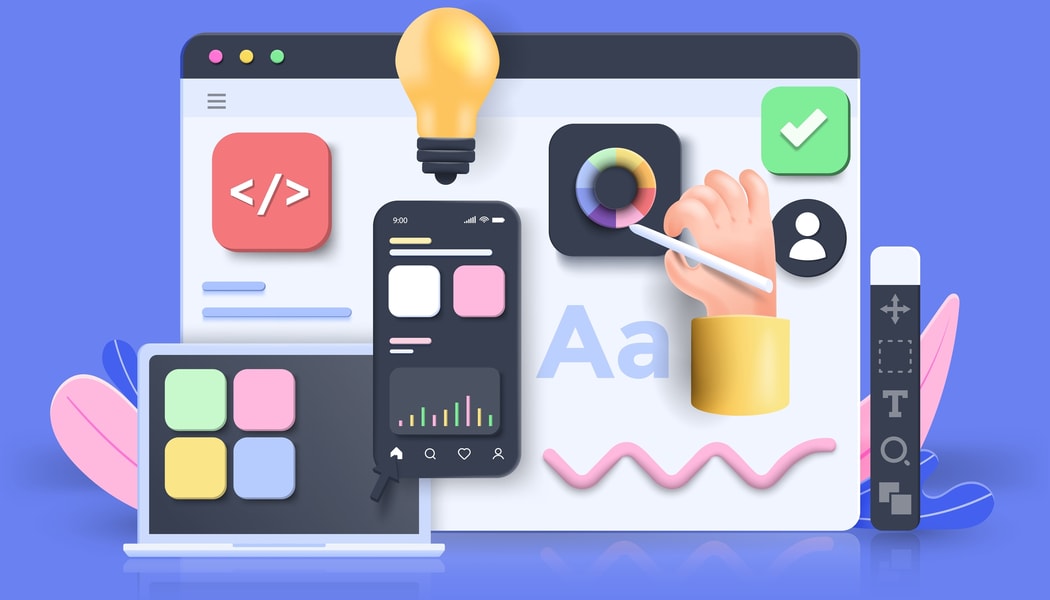What is Illustration? Types and Techniques (2024)
Learn the basics of what makes a great illustration and how to create one for your business.
 December 8, 2023
December 8, 2023 7 minute reading
7 minute reading
Illustration has served a vital role on our earth for as long as humans have existed, from the earliest cave drawings to the most sophisticated digital artworks of today. Whether they’re used to accompany literature, sell a product, or represent complex data, illustrations actually play a vital role in how our brains work.
The first step to truly understanding the importance of illustrations, however, comes with knowing the different types and techniques, as well as how this practice differs from other similar fields.
If you’re thinking of hiring an illustrator for an upcoming project or are looking to become a professional illustrator yourself, this guide will teach you everything you need to know about this creative field.
What is illustration?
Illustration is a visual form of art that conveys information, ideas, or narratives through images. It's often used in books, magazines, advertisements, or digital media.
In the 19th century, advances in printing technology, such as lithography and wood engraving, revolutionized illustration, making it a major part of mass media like books and newspapers. In this era, images were moved from hand-crafted to mechanical, influencing graphic design and visual storytelling a lot.
For example, consider a children's book where colorful, hand-drawn illustrations make it more engaging and easier for young readers to understand and connect with the narrative. Illustrations can also make apps more user-friendly and help guide users to take action.
Overall, good illustrations enhance comprehension, grab attention, and enrich the overall reading experience.
Different Types of Illustrations
In order to fully understand "what's an illustration?", we must first look at the various ways to use illustrations.
Editorial Illustration
An editorial illustration is one that was drawn to help explain a concept from a text. Often, you will find editorial illustrations in magazines, newspapers, book covers, or online resources. Editorial illustrations must always accompany the text, as their role is simply to add to the content’s mood, idea, or information.
They can also entice potential readers and persuade them to read the accompanying content.
Advertising Illustration
An advertising illustration is a type of artwork that is used in promotional materials with the primary goal of grabbing the viewer's attention. It can be used without any text or just the company's logo, but it must represent a powerful message to be memorable and effective.
Concept Art
Concept art is usually made for the locations, characters, costumes, and objects used in movies, video games, graphic novels, and comic books. This illustration style is used as a starting point to help creators define the style and design of different visual elements.
Concept art is often produced in multiple stages and must undergo feedback from numerous stakeholders. The most essential thing is to pick the most fitting image, not the most beautiful.
Fashion Illustration
Fashion illustration is a technique for visualizing clothes before they're produced. Fashion designers frequently use these drawings during their creative process.
The majority of fashion illustrators work on projects for fashion publications, websites, or companies to improve the visual appeal of concepts to potential buyers. They're also used by stylists and fashion consultants to assist their clients in making style decisions.
Technical Illustration
A technical illustration depicts something accurately to make it easier to understand. The clarity and simplicity of the drawing are more important in technical illustration than the image's beauty.
Blueprints, technical publications, manuals, technical diagrams, and equipment installation images are some of the most popular formats for technical illustrations. Typically, technical illustrations are created using dedicated software programs.
Infographics
Infographics are a collection of pictures and diagrams, accompanied by little text, that helps viewers quickly grasp the essential facts of a topic.
Not only do they make information easier to comprehend, but infographics also provide a large amount of data at-a-glance.
Infographics are associated with graphic design and communication; however, they can also be classified as a type of illustration.
Packaging Illustration
Packaging illustration helps brands to sell their goods, much like advertising illustration. It should be eye-catching and attract the viewer's attention while highlighting particular product features.
The goal of packaging illustration is to also give a product a personal touch and help to establish the brand.
Packaging illustrators frequently coordinate with consumer safety groups to ensure the images accurately reflect the products in a way that doesn't put consumers at risk.
Scientific illustration
A scientific illustration is a type of illustration that depicts things related to science, like biological organisms, medical procedures, and geological structures. By providing clear, detailed visual representations of complex scientific concepts, it plays a crucial role in education and research.
Taking a detailed illustration of human anatomy in a medical textbook as an example, students and professionals can visualize the intricate body structures.
The Difference Between Graphic Design and Illustration
The major difference between graphic design and illustration is in how and where they're used. Graphic design is often used commercially, whereas illustration is more closely tied to fine art.
Illustrations are a type of visual representation of written material. They might be used to demonstrate an idea, tell a narrative, or simply provide decoration. They’re created in a variety of formats, including both traditional and digital.
Graphic design, on the other hand, is the art and practice of solving problems and communicating ideas using visual elements such as typography, images, color, and shape. While graphic design focuses on communicating with its target audience, an illustration's meaning is all about creative interpretation. Additionally, graphic designers are usually guided by marketing and branding tactics, rather than words or storytelling.
Illustrators are typically hired for their unique style and artistic ability. Graphic designers often maintain their anonymity more because their primary goal is to express someone else's ideas through conventional design elements.
As commercial projects have begun to demand more expressive and unique imagery, however, the distinctions between graphic design and illustration are becoming less obvious.
Find the best Illustration services
The Difference Between Art and Illustration
Although illustration is closely tied to fine art, both fields have their differences. To begin with, fine art focuses on aesthetics for decorative purposes, while illustration is more functional.
Illustrations are often produced for business advertisements, publications, and product marketing. Fine art, on the other hand, is made for personal satisfaction and public display.
Fine art is an artist's self-expression through their craft. It's usually carried out for the artist's own satisfaction with little regard for the demands of the audience. Illustration, however, is the process of producing art that portrays an idea or solves a communication challenge. Its main aim is to convey a particular message to a target audience.

The Best Illustration Techniques
The most popular illustration techniques can be divided into two categories: traditional and modern.
Illustration techniques have evolved over time as materials have shifted and evolved. Artists used to primarily work with paper, paints, and pencils, but as the digital era progressed, many illustrators made the switch to working digitally.
1. Woodcutting
Woodcutting is an ancient illustration technique that involves using tools to carve a design into the surface of a wooden block. The non-printing areas are removed, while the printing sections are left level with the block's surface. The uncut regions of the block are inked and printed, whereas the recessed areas which were cut away don't hold ink and remain blank in the final print.
Woodcutting is the most ancient method of printmaking and rose to popularity during the Middle Ages. These carved block illustrations allowed for beautifully detailed images to be reproduced from the same master cutting and published across numerous books.
The illustration style is celebrated for its distinct contrast and larger strokes. It's still used to this day by contemporary illustrators who enjoy the technique’s textured appearance and rougher style.
2. Metal Etching
In metal etching, a copper, zinc, or steel plate is coated with the acid-resistant waxy ground. The artist then uses a sharp etching needle to scratch away the ground where they want lines to appear in the completed piece, revealing the bare metal underneath.
The plate is then submerged in an acid bath, where the acid eats into the exposed metal, leaving lines buried in the plate. Next, the plate is cleansed of any leftover ground. The plate is then inked all over, before being wiped clean of the ink. This leaves just the ink in the carved lines.
The plate is also fed into a high-pressure printing press with a piece of paper, which absorbs the ink from the scratched lines and produces a print. Depending on the specific technique used, the illustration may be similar to a watercolor (aquatint) or a pencil drawing with fine lines and hatching.
3. Pencil Illustrations
Creating illustrations using a pencil is one of the most popular techniques. Pencils are a complex medium that lets you produce delicate shadowing and transitions, as well as crisp and precise lines. It’s good for creating fonts, detailed sketches, and realistic portraits.
Illustrators sometimes like to keep the pencil drawing loose and draft their project with a pencil before finishing the illustration with another medium. This approach is particularly common when designing concept art.
4. Charcoal Illustration
Although charcoal illustrations are not as crisp and accurate as pen and pencil drawings, they are ideal for quick sketches and accompanying short stories. The blendable nature of charcoal allows the illustrator to create a variety of textures, which is useful for depicting materials, shadows, people, objects, and nature.
Artists commonly use their fingers and tissues to mix, smudge, and produce smooth and subtle shadowing.
5. Lithography
Lithography is a technique that involves drawing an image on the surface of a flat, level lithographic limestone plate using oil, lard, or wax. Since the 1960s, it has become the most widespread type of printing technology.
These days, offset lithography is now used to print most high-volume publications – especially those featuring color illustrations. The technique produces a slightly softer picture with washed-out colors.
6. Watercolor Illustrations
Watercolor illustrations use color pigments and water to produce subtleties and varied transparencies. These illustrations are favored for their delicate, light, and layered qualities. Due to their softer nature, they are commonly used in recipe books, fashion illustrations, and children’s Illustrations.
7. Gouache Illustrations
Gouache paint is similar to watercolor in that it is a water-medium paint. This technique produces stronger, thicker, and slightly darker colors than watercolor and may be modified years after completion.
Gouache is frequently used by commercial illustrators for projects such as posters, drawings, comics, and other visual work. The use of the gouache as "poster paint" is advantageous since the paint layer dries fully due to the rapid evaporation of the water.
8. Acrylics Illustration
Acrylics are one of the most popular techniques for beginner illustrators, as this paint is easier to work with than water-mediums or oil-based paints. These paints are quite diverse since they're available in fluorescents, metallics, and other intriguing styles.
They can also be painted on practically any surface and, once dried, they become water-resistant.
9. Collage Illustration
Collage illustration is a technique in which an artwork is created by assembling many forms, usually from various materials, to produce a new work of art.
Illustrators frequently use the shading from the many layers of their collage to achieve depth and create a 3D impression. Collage illustrations have grown in popularity in recent years and are frequently seen in advertisements, magazines, and children's books.
10. Pen-and-Ink Illustration
Ink illustrations are created by using a single color of ink on a light backdrop, which allows for greater contrast works.
Inks are a commonly available and inexpensive medium for working expressively with, plus they're also portable.
Without working with ink and brush, however, producing gradations in contrast can be difficult. Depth, on the other hand, can be generated by adding dots and strokes with varying weights and spacing between them.
11. Freehand Digital Illustrations
Freehand digital illustrations are created in a similar way to how artists use pen and ink to create more traditional art styles. In this modern technique, however, digital illustrators use a tablet and tablet pen to bring their creations to life in apps like Adobe Illustrator or Photoshop.
Smooth light and shadow changes, as well as complex backdrops and finer details, are all possible with freehand digital illustrations.
These illustrations are commonly used for storyboarding, animation, advertisements, book illustrations, and more.
The majority of freehand digital illustrations are created in raster format. This means they can only be scaled up and printed to specific sizes before losing their high quality.
12. Vector Graphics
Vector graphics are another digital form of illustration and their strong edges, shapes, and crispness make this technique easy to identify.
Unlike freehand digital drawings, they can be scaled up or down without losing their high quality. This makes vector graphics very popular for web illustrations and print media.
Vectors aren't really used for producing realistic art or adding features to existing imagery, however, unlike freehand digital drawings.
When it comes to illustration, keep in mind that there isn’t a single technique that’s better than others. Rather, it comes down to the purpose of the illustration, as well as the preferences of the illustrator and their client.
How to Become a Professional Illustrator
Whether you're fresh out of art school or simply switching career paths, making the transition into professional illustration is as much about how you present your work, as it is about your skill set.
Hone Your Illustration Style
Whether you want to professionally illustrate books, editorials, or greeting cards, understanding your aspirations and polishing your illustration style can help you gain focus.
While you may be capable of illustrating anything from realistic portraiture to abstract digital art, a jack-of-all-trades attitude can often mislead potential clients. Plus, it can divert you away from what you truly want to focus on.
The most accomplished illustrators have instantly recognizable art and distinctive points of view. If you want to pursue illustration as a career, the first thing you need is a consistent portfolio of work.
Showcase and Pursue the Work You Want to Get Hired to do
If you want to establish a profession doing something you're passionate about, include the exact kind of illustrations you want to keep doing in your portfolio. Think of your portfolio as your creative resume and keep the end goal in mind while you piece it together.
Narrowing the emphasis of your portfolio can assist an art director in identifying your specialty, but if you want to work on a variety of illustration projects, you may want to take a more varied approach.
When creating your portfolio, keep the following tips in mind:
Having an online portfolio is crucial for building a client base
A portfolio is similar to a menu. You should only offer what you want somebody to order
A slow-loading portfolio can turn off potential clients. Use full-size artwork instead of small thumbnails that must be enlarged and ensure your images are web-optimized
Don't opt for quantity over quality. Only showcase your best work
Successfully Manage Client Communication and Expectations
The next important step is to manage client communication, from their expectations to determine exactly what they want you to complete.
Recognize that those wishing to hire illustrators have a particular need. They may like your style, which sparks a dialogue, but they're often seeking something quite specific. This makes effective communication and asking a lot of questions even more crucial.
Successful illustrators are those who constantly have clients coming back for more. To achieve this, ensure you’re always meeting your deadlines. Additionally, consistently keep your clients, art director, or editor updated with your progress.
Enjoy the Exciting Journey of Illustration
As you’ve learned, there is much more to illustration than meets the eye. From the various illustration meanings to the wide array of illustrating techniques – you now have a more thorough understanding of the elements that make up an illustration and how they work together to create a distinct and emotive work of art.
If you’re thinking about pursuing illustration design as a career, then you’re embarking on a challenging, yet thrilling, journey. By following the advice set out in this article, you’re well on your way to becoming a professional in this field.



